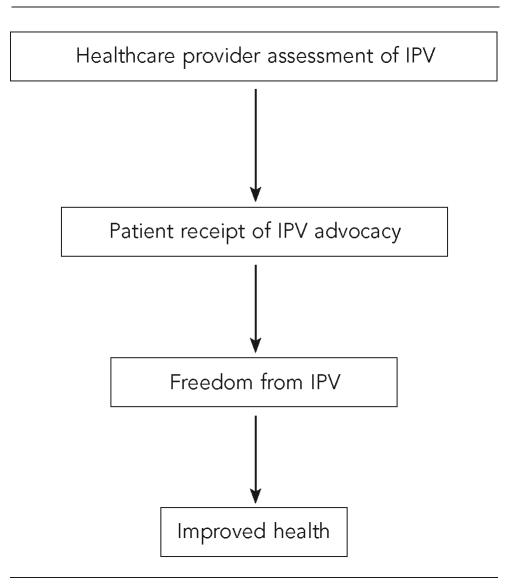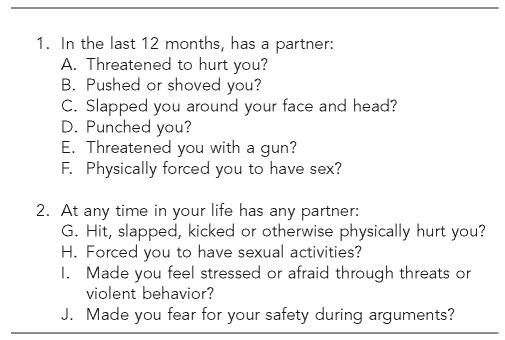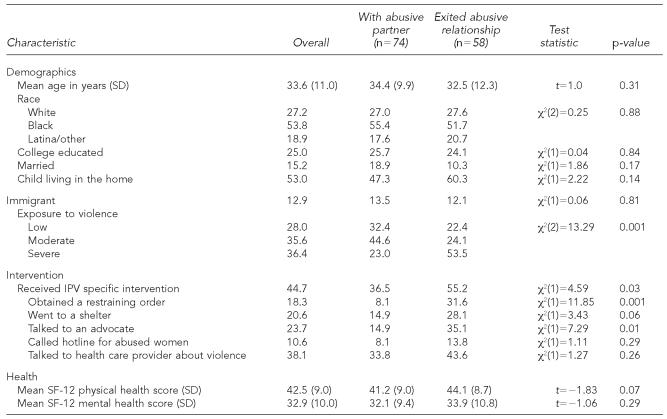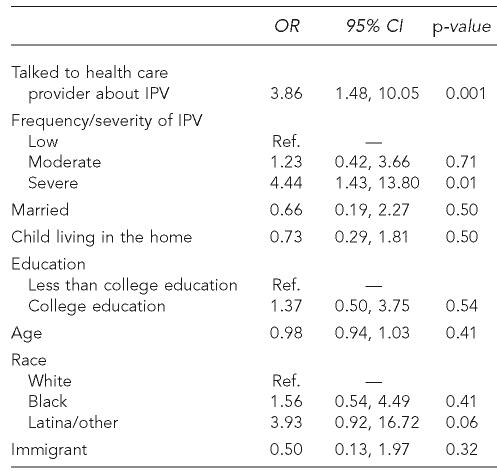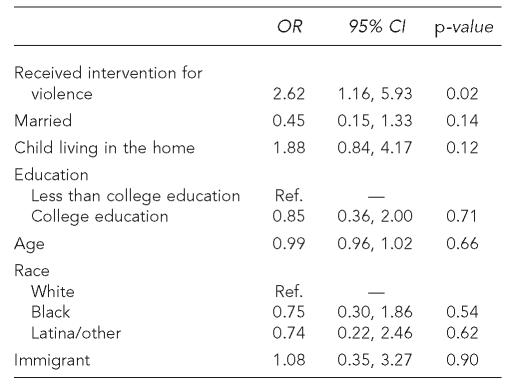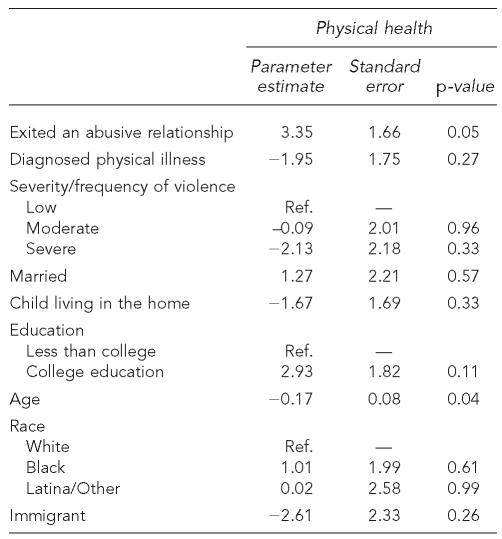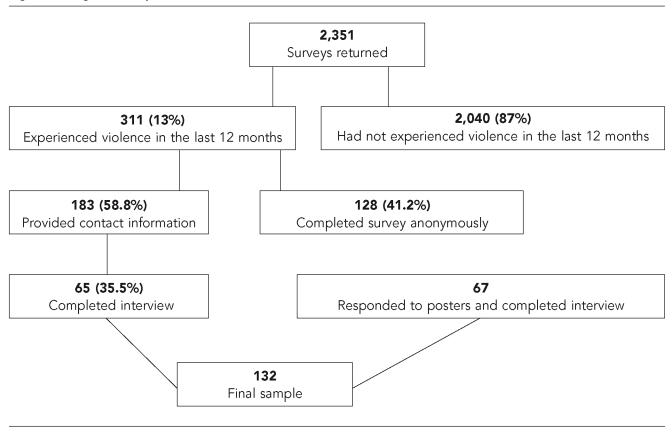SYNOPSIS
Objective
This study investigated whether disclosure of violence to health care providers and the receipt of interventions relate to women’s exit from an abusive relationship and to their improved health.
Methods
A volunteer sample of 132 women outpatients who described intimate partner violence during the preceding year were recruited from multiple hospital departments and community agencies in suburban and urban metropolitan Boston. Through in-person interviews, women provided information on demographics, past year exposure to violence, past year receipt of interventions, and whether they disclosed partner violence to their health care provider. They also described their past month health status with the 12-Item Short-Form Health Survey and further questions.
Results
Of the 132 women, 44% had exited the abusive relationship. Among those who were no longer with their partner, 55% received a domestic violence intervention (e.g. advocacy, shelter, restraining order), compared with 37% of those who remained with their partner. Talking to their health care provider about the abuse increased women’s likelihood of using an intervention (odds ratio [OR]=3.9). Those who received interventions were more likely to subsequently exit (OR=2.6) and women no longer with the abuser reported better physical health based on SF-12 summary scores (p=0.05) than women who stayed.
Conclusions
Health care providers may make positive contributions to women’s access to intimate partner violence services. Intimate partner violence interventions relate to women’s reduced exposure to violence and better health.
Despite the recognition that intimate partner violence presents a health risk to women, it remains controversial whether health care providers should routinely ask women about intimate partner violence (IPV).1,2 There is scarce evidence that medical “screening” for partner violence results in reduced violence exposure or enhanced health for patients.3–5 Providers are sometimes reluctant to ask about abuse when they are unsure that domestic violence services confer benefits. Recent reviews conclude that there is insufficient evidence that IPV services improve women’s circumstances or health.1,6 In March 2004, the U.S. Preventive Taskforce was unable to recommend screening in medical settings for partner violence, citing insufficient evidence that services are effective.2
Questions remain about whether detection in health care settings leads to receipt of domestic violence interventions, and whether such interventions result in less violence exposure or improved health. There are no studies tracing the pathways of response to potential health outcomes from communication with a health care provider about abuse to ultimately enhanced health. In our study we attempt to link several key points of intervention with two outcomes: exiting an abusive relationship and overall health status.
In our study we attempt to link several key points of assessment and intervention with two outcomes: exiting an abusive relationship and overall health status. What constitutes benefit is disputed and different authors apply various criteria. The notion that an abused woman necessarily wants to leave the relationship, or the view that advocates should promote relationship break-up, has been criticized as dismissing women’s own goals and desires. Nevertheless, remaining within the orbit of an abusive partner exposes women to many physical and psychological threats, and exiting can be seen as one step towards ultimate freedom from violence.
There are several kinds of interventions designed for abused women in the United States: (1) telephone hotlines to provide information and referrals; (2) “outpatient” intimate partner violence advocacy and counseling offered through hospital or community-based programs, including shelters; (3) residential shelters with in-house services dedicated to abuse; (4) court-sponsored protection through civil restraining orders of violent offenders. Further criminal justice approaches beyond the scope of our present study include preventive police notification of domestically violent households, detention, arrest, and prosecution. Despite the relative paucity of evaluations for domestic violence-dedicated services, some encouraging findings have emerged. From the few studies available, it appears that intimate partner violence advocacy and civil protection orders do confer benefit. For instance, in a randomized controlled trial of abused women in Michigan recruited from shelters and assigned to a 10-week advocacy program, those receiving advocacy were less likely to be the victims of violence two years later when compared to the control group.7 Longer follow-up yielded fewer differences between intervention and control groups in violence exposure, but still quality of life and social support were enhanced among those receiving advocacy.8 In Seattle, women whose partners had been arrested for intimate partner violence reported less dangerous or escalated forms of abuse after filing a civil protective order, compared to women who did not take out a restraining order.9 Women with a civil protection order were also less likely to be hospitalized in the subsequent year for a range of serious conditions.10 The act of filing a court order accounts for a reduction in violence exposure even when the court fails to grant the order.11
Nevertheless, there are still gaps in our knowledge of how much interventions help and whether they promote women’s health—a key question for medical practitioners.
Outside the debate about whether domestic violence interventions are effective is the question of whether assessing intimate partner violence in medical settings actually results in heightened access to services and eventual life changes (including leaving an abusive partner and whether women who leave abusive partners are healthier than women who stay). It is unknown whether health care provider screening predicts women’s receipt of interventions, or whether women’s health improves as a result.
In our study we interviewed abused women, half of whom were screened directly from health care settings, to gain specific information about the relative timing of violent incidents to interventions, and the influence of interventions on exiting the relationship. Our study questions trace the steps from the initial public health response to intimate partner violence—provider-patient communication (see Figure 1). First, when health care providers do screen for intimate partner violence and discuss referrals, are women more likely to use domestic violence services? Second, do women who receive intimate partner violence interventions exit sooner than abused women who do not receive such services? And, finally, does exiting an abusive relationship result in better health? Findings were based on an interview study of women who reported intimate partner violence and receipt of interventions in the previous 12 months.
Figure 1.
Conceptual Model
METHODS
Recruitment of participants
Participants (N=132) were women who were victims of intimate partner violence during the 12 months preceding the in-person interview. Only women in a relationship with a man during the past 12 months were included in the study, and only women in heterosexual partnerships were interviewed due to the small sample of women who indicated on the hospital-based survey that they were in a same-sex relationship.
Abused women were identified and recruited through two approaches. First, efforts were made to obtain a representative sample of women patients with a recent abuse history by surveying waiting rooms in medical departments throughout the city of Boston, including emergency (n=4), obstetrics/gynecology (n=4), primary care (n=2), addiction recovery departments (n=1), and a Planned Parenthood clinic.12 Women patients were surveyed across a random distribution of time points over several months. Surveys were distributed in several languages besides English to capture the language and ethnic diversity of the patient population (e.g., Spanish, Chinese), but most were filled out in English. The overall return rate of surveys across departments was 63%. Out of 2,351 women who returned the survey with complete responses to the questions about intimate partner abuse, 14% (N=311) confirmed at least one episode of domestic violence within the past 12 months based on 10 items (see Figure 2).13–15 Of these women, 60% (n=183) provided contact information for in-person interviews and slightly less than half (n=65) were successfully scheduled for interviews. Women who completed an interview were less likely to have completed any education beyond high school and were more likely to make less than $20,000 a year than women who did not complete an interview; there were no significant differences in race, marital status, or age.
Figure 2.
Survey questions
To augment the sample size of abused women, we advertised with posters in hospitals and shelters for abused women volunteers (n=67). The posters advertised for women who had a partner within the past year who “scares you,” “hits, pushes, chokes or physically hurts you in any way,” or “is jealous or possessive, won’t let you have friends, or checks up on you.” Posters were distributed in the same medical sites and at community agencies. To ensure that the women responding to the posters came from the same population source as the hospital-surveyed women, only women who confirmed that they were patients at one of the participating hospitals or a satellite clinic were included. Although women recruited from posters were not present in the waiting rooms when we were actually distributing the screening instruments, they had been seen at one of the participating clinics during a generally overlapping time frame (i.e., the past year). In addition, women who called as a result of seeing the posters were asked the same screening questions to determine their eligibility as women in the health care sites. Poster-recruited women were more likely to be black (72% vs. 35%; χ217.6; p,0.001) and older (37 years of age vs. 30 years; t=4.3; p,0.001). There were no further differences in demographics or type and degree of violence exposure between poster- and survey-recruited women. Because there were some key differences, however, sampling method was entered as a co-variate in our regression models. Our final sample included 132 women (see Table 1).
Table 1.
Characteristics of the sample of battered women (N=132)
SD 5 standard deviation
Procedure
The sponsoring university and all participating hospitals granted Institutional Review Board approval following a full review. The hospital-based screening occurred before the enactment of HIPAA regulations. Interviews were held in offices near some of the hospitals participating in the study, at a location accessible through public transportation within the city. Transportation was compensated and in some cases taxicabs were provided. All women provided informed consent, were guaranteed full confidentiality, and received $25 in compensation. Interviews lasted about two hours. Interviewers were women who received four to six weeks of training and most were enrolled in graduate school in public health. Interviewers were matched with the interviewee on race or ethnicity as often as possible, and Spanish-speaking interviewers were available, although all interviews were conducted in English.
Measurement
Demographic variables
Demographic variables that have been shown to influence a woman’s decision to leave an abusive relationship were included as control variables in the regression analyses.8,16,17 These variables reflected economic dependence (i.e., educational level attained) and commitment (i.e., marital status, whether they have children). Women who are economically independent and who have a less entrenched commitment are more likely to leave an abusive relationship sooner than economically dependent and committed women.16,17 Age, race/ethnicity, and immigrant status (i.e., U.S.-born or born outside the U.S.) were also included in the adjusted models.
Exposure to intimate partner violence
The violence subscales of the revised version of the Conflict Tactics Scale were administered to assess women’s experiences with violence within the previous 12 months.18 Questions pertained to physical abuse and threats, and sexual abuse. Women were asked how often in the past year they experienced 26 different types of violence on a seven-point Likert scale ranging from “none” to “more than 20 times.” To obtain an estimate of the actual degree of exposure, we converted the scale to an actual number of events, selecting the midpoints for response categories (such as “4” in the category 3–5 times). A weighted score was then created by summing the values of the 26 items.18 These scores ranged from 1 to 533, with a mean of 67.2 and a median of 34.5. The scores were recoded into terciles to create a categorical variable reflecting three levels of intimate partner violence severity (low violence=1–12; moderate violence=13–50; severe violence=51, and over). The highest tercile (severe) reflects exposure to frequent, repetitive, and escalated forms of physical or sexual abuse.
Interventions
We asked women whether they had used any of the following dedicated intimate partner violence services within the previous 12 months: (1) hotline, (2) advocate or intimate partner violence counselor, (3) shelter stay, (4) restraining order. Women who affirmed use of any such services were classified as having used an intimate partner violence-focused service during the 12 months preceding the interview. In addition, women were asked, “Have you told a doctor or other health care professional about your experiences with violence during the past year?”
Relationship status
Women were asked whether they had exited their abusive relationship during the past year and when the relationship ended.
Health
The 12-Item Short-Form Health Survey (SF-12)—a shortened version of the SF-36, a standardized instrument with established psychometric validity often used in health services research—was to assess self-reported physical and mental health.19,20 The SF-12 measures eight health concepts: physical functioning, role limitations due to physical health, bodily pain, general health, vitality (energy/fatigue), social functioning, role limitations due to emotional health, and mental health (psychological distress and psychological well-being). Two summary scales can be constructed through the application of regression weights to the 12 items—the physical components summary (PCS-12) and the mental components summary (MCS-12)—that approximate the PCS and MCS of the SF-36. A high score on either scale implies better health, and scores are normalized to the U.S. population, for which the mean value is 50 and the standard deviation is 10.
Women were also asked whether they had any other diagnosed medical conditions out of a list of nine conditions (e.g., arthritis, asthma, cancer, diabetes). Because most women in the study were relatively young and rarely had more than one health condition co-morbid with violence, a dichotomous indicator of self-reported physical illness was entered as a control variable in regressions of health outcomes.
Data analysis
Associations between demographic characteristics, intervention, and outcome variables were examined by women’s exit status using chi-square and t-tests (Table 1). We then estimated three multiple regression models (Tables 2, 3–4) to address each of the following questions, conceptualized in order of effect: (1) Is talking with a health care provider related to accessing interventions? (2) Are women who receive services more likely to exit the abusive relationship than women who do not receive such services? (3) Are women who exit in better self-reported health than women remaining in the abusive relationships? The first two questions were modeled using logistic regression and were adjusted for variables indexing relationship commitment or dependency (i.e., married, having a child, education), and the demographic variables of age, race/ethnicity, and immigration status. We controlled for severity of violence in the first logistic regression model examining women’s receipt of interventions because we hypothesized that women who reported the highest levels of violence would be most likely to turn to interventions, and bivariate tests revealed a strong association between severity of abuse and intervention-seeking behavior.
Table 2.
Adjusted logistic regression analysis estimating receipt of interventions for intimate partner violence in the previous year (N=132)a
Adjusted for sampling method (hospital vs. poster recruitment)
OR = odds ratio
CI = confidence interval
Table 3.
Adjusted logistic regression analysis estimating associations with women’s exit from violent relationships (N=132)a
Adjusted for sampling method (hospital vs. poster recruitment)
OR = odds ratio
CI = confidence interval
Table 4.
Adjusted linear regression analysesa of physical health using PCS of SF-12 (N=132)
R2=0.1464
Adjusted for sampling method (hospital vs. poster recruitment)
PCS=physical components summary
SF-12=12-Item Short-Form Health Survey
Given the strong relationship between violence severity and receipt of interventions, severity of violence was not included in the second logistic regression model predicting women’s exit from abusive relationships, due to collinearity concerns.
The models of the relationship between exiting an abusive relationship and the physical and mental health component scales of the SF-12 were estimated using multiple linear regression. Demographic variables, IPV intervention, and violence severity were included in this model as control variables. Participant recruitment method (whether recruited through hospital survey or through volunteer posters) was entered into all equations to control for the two methods of sampling.
RESULTS
Descriptive statistics
Nearly half (44%) of the abused women had left the relationship by the time of the interview. Of women who exited, 55% received an intervention within the previous year in contrast to 36% of women still with their abuser (χ2[1]=4.6; p=0.03).
Table 1 displays the characteristics of the total sample of women in our study and by relationship exit status. Chi-square and t-tests revealed no differences on a number of key demographic variables between those who departed from the abuser and those who stayed, including age, race, or immigration status; nor were there differences on those variables relating to educational level attained, the level of commitment as indexed by marital status, or whether there were children. Women who left were more likely to describe severe violence than women who stayed (53.5% vs. 23%; χ2[2]= 13.29; p=0.001).
Of women who received any service, more than 36% made use of more than one outlet during the previous year. The most common resource was an intimate partner violence advocate (24%). More women who received a single intervention left the relationship(42%) than women who received no services (36%), but the effect was more dramatic for those women who exercised two or more options (76%). It is important to establish whether interventions were received before women actually exited the relationships in order to be more confident of a potential causal link. Of the women who did exit from their abusive partners and who also received interventions, and for whom we had complete information on the dates of interventions and departure (n=33), 84% received interventions before their relationship exit date.
About 38% of the women talked about their relationship problems with their health care provider, but talking with their provider was unrelated to whether they left. Based on SF-12 scores, women who exited the relationship reported better physical health status (mean PCS=44) than women who were still with an abusive partner (mean PCS=44.2; t[1, 132]=‡1.83; p=0.07).
Regression analyses
The first multiple logistic model (Table 2) addressed what predicts access to interventions, and especially whether disclosing abuse to a health care provider makes a difference. The discrete outcome, therefore, was the receipt of any domestic violence interventions, controlling for marital status, child living in the home, education, age, race/ethnicity, and immigrant status. Severity of violence was highly related to service use, with an odds ratio (OR) of 4.44 (95% confidence interval [CI] 1.43, 13.8). Talking with a health care provider about relationship problems and violence was also highly related to the receipt of services (OR=3.86; 95% CI 1.48, 10.05). Over and above talking with a health care provider, Latina/other women were nearly four times more likely to access services than Anglo, white women, although the confidence interval was large (p=0.06).
The second multiple logistic regression model addressed the question of whether interventions predict departure (Table 3). Again controlling for key variables, which are known to relate to women’s departure from an abusive relationship, those who received interventions were more likely to exit (OR=2.62; 95% CI 1.16, 5.93). Use of interventions was the only significant indicator of relationship exit in the model. In this model, Latina women, although more likely to receive interventions than others based on our previous regression model, were no more likely to leave than other women when interventions were entered into the equation. This finding suggests that when Latina women make use of interventions, they derive the same level of benefit as other women.
The final model was a multiple linear regression with the normalized scores on the physical component of the SF-12 as the dependent variable. The key independent variable was exiting an abusive relationship. Women’s self-reported physical health was better if they were no longer in an abusive relationship (p=0.05). This model explained about 15% of the variation in the physical health component of SF-12 scores. A linear regression model predicting the mental health component of the SF-12 was estimated, but there was no relationship between exiting and women’s mental health scores (results available from authors upon request). Our hypothesis that leaving an abusive relationship corresponds to improved health was confirmed.
DISCUSSION
Our findings lend support to several linked propositions: (1) Discussing partner violence with health care providers is associated with women’s use of interventions; (2) Women who receive interventions are more likely to leave their abuser; (3) Exiting an abusive relationship is related to improved health. Each of these conclusions bears on how health care providers might respond to their patients’ abuse disclosure. It appears from our results that health care provider communication could make a large difference in whether women access services. Women who received intimate partner violence services were nearly three times more likely to have reported exiting the relationship compared to women who did not receive such services. There are also ethnic differences in who uses domestic violence resources, with Latina/other women displaying higher odds of receipt of interventions. In contrast to some notions that Latina women are reluctant to use domestic violence services, our findings indicate that they have a high likelihood of using such resources, consistent with at least some previous findings.21
Our analyses revealed that physical health status was better among women who had left an abusive relationship. The health consequences of being in an abusive relationship are anything but minor, as we know from other studies comparing abused and non-abused women on health outcomes,3 and our findings are consistent with these studies. Long-term health benefits of living without violence cannot be established in the present one-year study, but one would anticipate a cumulative advantage over time. The women’s physical health summary (PCS-12) scores are lower in the present sample than national averages for population-based studies of American women, which may be related to their prior experiences with IPV (42.5 [SD 9.0] vs. 49.1 [SD 9.9]).17
Although it was somewhat surprising that exiting an abusive relationship failed to distinguish women on mental health status, such a finding could be attributable to the perseverance of mental health problems following the end of an abusive relationship, and even the distress caused by the break-up and emotional upheaval.18 Exiting an abusive relationship carries the same burden of loss and grief that any relationship loss might entail. By looking only at whether women remain in or exit abusive relationships, we are using a restricted assessment of women’s responses to violence. Leaving an abusive relationship is a major step for a woman to take. Some researchers adopt a “reduction of harm” approach to measuring the outcome, such that a reduction in violence episodes or other positive changes short of ending the relationship would be an indicator of success.8 The focus on exiting has also been critiqued by feminist researchers as imposing an agenda on women’s lives and failing to fully respect the range of their adaptations. Nevertheless, the view that many abused women are unmotivated to leave is not held up by our findings here, nor in previous longer-term studies of women in abusive relationships.22 Despite the high threshold for finding an effect of interventions when exiting is used as the outcome measure, we did find that receipt of an intervention held a positive relationship. Selection of less dramatic outcomes might yield even stronger results.
Exiting is also not a perfect indicator of freedom from violence. In fact, it is after a break-up that women are at the most acute risk for femicide.23 Nevertheless, being out of the personal orbit of an abusive partner is likely to result in the long term in substantially reduced violence exposure, despite the heightened risk of crises at the early points of the break-up. Leaving an abusive relationship is a subtle process, takes time, and is hard to track because abused women are very hard to retain in longitudinal research studies. Yet it would appear to be an important first step in living without intimate partner violence. Ending a relationship with an abusive partner is also a shorter route to safety and health than waiting for the abuser to change. Studies of interventions with abusive men are not encouraging in this regard.
Limitations
There are various limitations to our study and to the generalizability of our results. First, the sample collapses two recruitment methods, and although our findings were corroborated between the sub-samples of hospital-recruited and poster-enlisted women, certainly a cleaner design would have relied on a single method of recruitment. We weighed these scientific costs against the rather extensive real costs of recruiting the women: more than 2,300 women were surveyed to interview 65 abused women. Posters offered a more rapid and less costly recruitment method. We believe our statistical controls in the regression models address the challenge. It should be noted that while we used a more representative sampling approach to obtain the women from hospital clinics, any in-depth study such as this one relies on women’s willingness to volunteer. It is also the case that virtually any in-depth study of abused women suffers from the potential self-selection of women who are willing to disclose or talk about the problem.
Our measurements also had some limitations, particularly of mental health. Research using more specific measures of mental health diagnoses have found differences in the mental health of women who exited relationships.24,25 Future research may want to include a more sensitive mental health diagnostic tool.
Our study relies on retrospective reports of intervention receipt and relationship exit. The retrospective reports lack detail on the precise timing of all events, such as whether women talked to their health care provider directly before meeting with an advocate. Therefore, directionality of the link between receipt of interventions and exiting an abusive relationship in this study should be interpreted with caution. While we are confident that most women accessed intimate partner violence interventions prior to exiting from their abusive relationship, the extent of missing data on the month of service access limited our ability to establish the precise timing. Further prospective research could be planned to trace the detailed causal chain of events in a woman’s trajectory to exiting a violent relationship, perhaps using diary methods if at all feasible.
CONCLUSIONS
Ideally, studies of effective interventions for domestic violence would be done using randomized designs. However, random controlled trials pose a unique challenge to studies of many social problems, including intimate partner violence. Not the least of such challenges is that people in real life self-select into treatment or services, so the artificial element of random assignment lacks ecological validity.26 Furthermore, in a recent review, Zink and Putnam note that issues such as randomization, identification of a control group, blinding of conditions, and long-term follow-up pose a challenge to research on intimate partner violence due to the hidden and unpredictable nature of the violence and safety concerns that limit ongoing contact.27 It is therefore especially laudable that some researchers have performed experimental evaluations of intimate partner violence interventions.8,28 The research on interventions to date, however, lacks a focus on patient populations or linking interventions to health status. The results of the present study provide insight into the naturalistic associations between interventions, exiting violent relationships, and women’s health in a patient-based sample. They highlight the central role health care settings have in connecting abused women to services that will reduce violence exposure and promote their health.
Figure 3.
Stages of sample recruitment
REFERENCES
- 1.Ramsey J, Richardson J, Carter YH, Davidson L, Feder G. Should health professionals screen women for domestic violence? Systematic review. BMJ. 2002;325:314. doi: 10.1136/bmj.325.7359.314. [DOI] [PMC free article] [PubMed] [Google Scholar]
- 2.U.S. Preventive Services Task Force. Screening for family and intimate partner violence: recommendation statement. Ann Fam Med. 2004;2:156–60. doi: 10.1370/afm.128. [DOI] [PMC free article] [PubMed] [Google Scholar]
- 3.Campbell JC. Health consequences of intimate partner violence. Lancet. 2002;359:1331–6. doi: 10.1016/S0140-6736(02)08336-8. [DOI] [PubMed] [Google Scholar]
- 4.Hathaway JE, Mucci LA, Silverman JG, Brooks D, Mathews R, Pavlos CA. Health status and health care use of Massachusetts women reporting partner abuse. Am J Prev Med. 2000;19:302–7. doi: 10.1016/s0749-3797(00)00236-1. [DOI] [PubMed] [Google Scholar]
- 5.Coker AL, Davis KE, Arias I, Desai S, Sanderson M, Brandt HM, Smith PH. Physical and mental health effects of intimate partner violence for men and women. Am J Prev Med. 2002;23:260–8. doi: 10.1016/s0749-3797(02)00514-7. [DOI] [PubMed] [Google Scholar]
- 6.Wathen CN, MacMillan HL. Interventions for violence against women: scientific review. JAMA. 2003;289:589–600. doi: 10.1001/jama.289.5.589. [DOI] [PubMed] [Google Scholar]
- 7.Sullivan CM, Bybee DI. Reducing violence using community-based advocacy for women with abusive partners. J Consult Clin Psychol. 1999;67:43–53. doi: 10.1037//0022-006x.67.1.43. [DOI] [PubMed] [Google Scholar]
- 8.Bybee D, Sullivan CM. Predicting re-victimization of battered women 3 years after exiting a shelter program. Am J Comm Psychol. 2005;36:85–96. doi: 10.1007/s10464-005-6234-5. [DOI] [PubMed] [Google Scholar]
- 9.Holt VL, Kernic MA, Lumley T, Wolf ME, Rivara FP. Civil protection orders and risk of subsequent police-reported violence. JAMA. 2002;288:589–94. doi: 10.1001/jama.288.5.589. [DOI] [PubMed] [Google Scholar]
- 10.Holt VL, Kernic MA, Wolf ME, Rivara FP. Do protection orders affect the likelihood of future partner violence and inquiry? Am J Prev Med. 2003;24:16–21. doi: 10.1016/s0749-3797(02)00576-7. [DOI] [PubMed] [Google Scholar]
- 11.McFarlane J, Malecha A, Gist J, Watson K, Batten E, Hall I, Smith S. Protection orders and intimate partner violence: an 18-month study of 150 black, Hispanic, and white women. Am J Public Health. 2004;94:613–8. doi: 10.2105/ajph.94.4.613. [DOI] [PMC free article] [PubMed] [Google Scholar]
- 12.McCloskey LA, Lichter E, Ganz ML, Williams CM, Gerber MR, Sege R, et al. Intimate partner violence and patient screening across medical specialties. Acad Emerg Med. 2005;12:712–22. doi: 10.1197/j.aem.2005.03.529. [DOI] [PubMed] [Google Scholar]
- 13.Marshall LL. Development of the Severity of Violence Against Women Scales. J Fam Violence. 1992;7:103–21. [Google Scholar]
- 14.McFarlane J, Greenberg L, Weltge A, Watson M. Identification of abuse in emergency departments: effectiveness of a two-question screening tool. J Emerg Nurs. 1995;21:391–4. doi: 10.1016/s0099-1767(05)80103-5. [DOI] [PubMed] [Google Scholar]
- 15.Abbot J, Johnson R, Koziol-McLain J, Lowenstein SR. Domestic violence against women. Incidence and prevalence in an emergency department population. JAMA. 1995;273:1763–7. doi: 10.1001/jama.273.22.1763. [DOI] [PubMed] [Google Scholar]
- 16.Strube MJ, Barbour LS. The decision to leave an abusive relationship: economic dependence and psychological commitment. J Marriage Fam. 1983;45:785–93. [Google Scholar]
- 17.Anderson DK, Saunders DG. Leaving an abusive partner: an empirical review of predictors, the process of leaving, and psychological well-being. Trauma Violence Abuse. 2003;4:163–91. doi: 10.1177/1524838002250769. [DOI] [PubMed] [Google Scholar]
- 18.Straus MA, Hamby SL, Boney-McCoy S, Sugarman DB. The revised Conflict Tactics Scales (CTS2): development and preliminary psychometric data. J Fam Issues. 1996;17:283–316. [Google Scholar]
- 19.Ware JE, Kosinski M, Keller SD. A 12-Item Short-Form Health Survey: construction of scales and preliminary tests of reliability and validity. Med Care. 1996;34:220–33. doi: 10.1097/00005650-199603000-00003. [DOI] [PubMed] [Google Scholar]
- 20.Ware JE, Gandek B. Overview of the SF-36 Health Survey and International Quality of Life Assessment (IQOLA) Project. J Clin Epidemiol. 1998;51:903–12. doi: 10.1016/s0895-4356(98)00081-x. [DOI] [PubMed] [Google Scholar]
- 21.Fernández-Esquer ME, McCloskey LA. Coping with partner abuse among Mexican American and Anglo women: ethnic and socioeconomic influences. Violence Vict. 1999;14:293–300. [PubMed] [Google Scholar]
- 22.Pancheswaradan S, McCloskey LA. Predicting the timing of women’s departure from abusive relationships. J Interpers Violence. 2006 doi: 10.1177/0886260506294996. In press. [DOI] [PubMed] [Google Scholar]
- 23.Campbell JC, Webster D, Koziol-McLain J, Block C, Campbell D, Curry MA, et al. Am J Public Health. 2003. Risk factors for femicide in abusive relationships: results from a multisite case control study; pp. 1089–97. [DOI] [PMC free article] [PubMed] [Google Scholar]
- 24.Campbell R, Sullivan CM, Davidson WS. Women who use domestic violence shelters: changes in depression over time. Psychol Women Q. 1995;19:7–255. [Google Scholar]
- 25.Wittenberg E, Lichter EL, Ganz ML, McCloskey LA. The utility of intimate partner violence: a comparison of quality of life across health conditions. Med Care. 2006 doi: 10.1097/01.mlr.0000215860.58954.86. In press. [DOI] [PubMed] [Google Scholar]
- 26.Seligman ME. The effectiveness of psychotherapy. The Consumer Reports study. Am Psychol. 1995;50:965–74. doi: 10.1037//0003-066x.50.12.965. [DOI] [PubMed] [Google Scholar]
- 27.Zink T, Putnam F. Intimate partner violence research in the health care setting: what are the appropriate and feasible methodological standards? J Interpers Violence. 2005;20:365–72. doi: 10.1177/0886260504267548. [DOI] [PubMed] [Google Scholar]
- 28.Thompson RS, Rivara FP, Thompson DC, Barlow WE, Sugg NK, Maiuro RD, Rabanowice DM. Identification and management of domestic violence: a randomized trial. Am J Prev Med. 2000;19:253–63. doi: 10.1016/s0749-3797(00)00231-2. [DOI] [PubMed] [Google Scholar]



